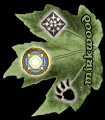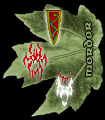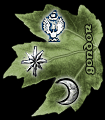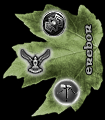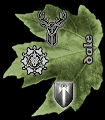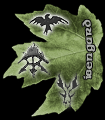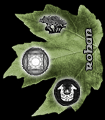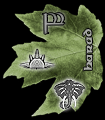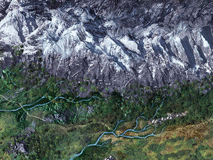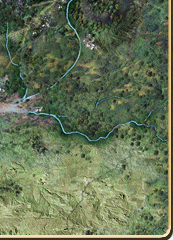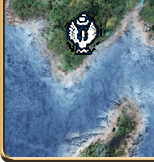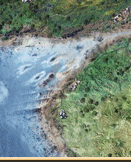|
'Spring was already busy about them: fronds pierced moss and mould, larchers were green fingered, small flowers were opening in the turf, birds were singing.' - The Two Towers. Ithilien was a fair, green region of Gondor on the borders of Mordor. Enemy forces passed through Ithilien many times throughout its history, but the land retained much of its natural beauty. After the War of the Ring, Ithilien became a princedom of Gondor and Faramir was made the first Prince of Ithilien. Ithilien was located on the east side the Anduin between the river and the Mountains of Shadow. North of Ithilien were the Wetwang, the Dead Marshes, and the Desolation of the Morannon. The River Poros formed the southern boundary of Ithilien. Between North Ithilien and South Ithilien flowed the Morgulduin, originally called the Ithilduin. The Morgul-road ran alongside the Morgulduin from the city of Osgiliath on the Anduin to the Morgul Vale in the Mountains of Shadow, where the stronghold of Minas Morgul that was once Minas Ithil was located. The road was intersected at the Cross-roads by the Harad Road, which ran through Ithilien from the southern lands to the Black Gate in the north. The hills called Emyn Arnen were in South Ithilien, within sight of Minas Tirith across the Anduin. In North Ithilien was the refuge of Henneth Annun behind a waterfall that spilled into the Forbidden Pool. The water flowed out of the pool and continued westward past the Field of Cormallen to the Anduin. There were many other streams and pools and falls in Ithilien, and it was called the land of many fountains. Ithilien was also known as the garden of Gondor. It was a land of lush vegetation, much of which had been planted by the Men of Gondor but had grown wild over time. There were groves of ash, bay, cedar, cypress, fir, juniper, myrtle, oak, and olive trees. The ground cover included heather, ferns, moss, and briars. Among the many flowers that bloomed in Ithilien were anemones, celandines, hyacinths, irises, lilies, and wild roses. Herbs such as marjoram, parsley, sage, and thyme grew there as well. The air of Ithilien was fresh and fragrant. Warm sea air flowed up from the south, while the land was sheltered on the east by the Mountains of Shadow and to the north by the hills of the Emyn Muil. When the full Moon set in the west, Ithilien was bathed in a silver light. Gondor was founded in 3320 of the Second Age. The capital city of Osgiliath was built on the Anduin - half in Anorien on the western bank and half in Ithilien on the eastern bank. In addition, King Elendil's sons Anarion and Isildur each had a stronghold on opposite sides of the river. Anarion dwelled in Minas Anor, which later became Minas Tirith, while Isildur built Minas Ithil in Ithilien as his home. Other structures were also built in Ithilien, including arched bridges over streams and a carved stone basin to form a small lake. At the Cross-roads was erected a great statue of a King. Sauron had secretly returned to Mordor and in 3429 of the Second Age, he seized Minas Ithil. Sauron was defeated by the armies of the Last Alliance in 3441 S.A. Minas Ithil was reclaimed and a watch was kept from there on Mordor. A guard was also kept in the Tower of Cirith Ungol, the easternmost outpost of the defenses of Ithilien. In 1432 of the Third Age, the civil war of the Kin-strife began. A group of rebels led by Castamir opposed King Eldacar's right to the throne because Eldacar's mother was not of Gondor but of the Northmen. Castamir laid siege to Osgiliath and in 1437 he captured the city. His forces slaughtered many of the inhabitants, including Eldacar's son Ornendil. Osgiliath burned and the Dome of Stars was destroyed and the palantir that had been kept there was lost. Eldacar escaped, and when he returned to reclaim the throne of Gondor ten years later, many of the people of Ithilien joined his forces because they remembered Castamir's cruelty. The Great Plague of 1636 claimed many lives. The guard on Mordor began to relax as Minas Ithil became deserted. Osgiliath was hardest hit, and many of its inhabitants fled into the lands of Ithilien. People also came to Ithilien from Calenardhon at this time. In 1944, King Ondoher of Gondor was defeated in battle by an army of Wainriders before the Black Gate. The Wainriders then invaded Ithilien from the north. At the same time, an army of Haradrim crossed the River Poros and entered South Ithilien. Earnil, the Captain of the Southern Army, defeated the Haradrim forty miles north of the river. Earnil then led his forces to North Ithilien, gathering the remnants of the retreating Northern Army to him, and they surprised the Wainriders in their camp. The Wainriders were defeated in the Battle of the Camp and were driven out of Ithilien. The Nazgul returned to Mordor and in 2000 they besieged Minas Ithil. They captured the city in 2002 and it became their stronghold and was renamed Minas Morgul. The Morgul Vale was a place of fear and dread, and many people fled from Ithilien. In 2050, King Earnur went to Minas Morgul to face the Lord of the Nazgul in single-combat. He was never seen again and it was from this time that the Stewards ruled Gondor in the absence of a King. In 2475, an army of black Uruks came out of Mordor and swept through Ithilien. They captured Osgiliath and the city was ruined and abandoned. Boromir, son of the Steward Denethor I, reclaimed Ithilien for Gondor but in the fighting he received a Morgul-wound that shortened his life. (Note: This Boromir is not the same as Boromir of the Fellowship.) The Haradrim once again invaded Ithilien in 2885. The Rohirrim came to the aid of Gondor and together they defeated the Haradrim at the Crossings of Poros. Folcred and Fastred, the twin sons of King Folcwine of Rohan, were killed in the battle. They were buried together on the banks of the Poros in South Ithilien. Their burial mound was called Haudh in Gwanur - Mound of the Twins - and the enemies of Gondor were afraid to pass it. Uruks from Mordor also made incursions into Ithilien. By 2901, most of the inhabitants of Ithilien left their homes and moved west of the Anduin, though a few hardy folk remained. Companies of Rangers patrolled Ithilien, and it was at this time that Henneth Annun and other refuges were built. Sauron returned to Mordor and in 2951 he declared himself openly. Mount Doom burst into flame in 2954 and the remaining inhabitants of Ithilien fled. All that remained were the Rangers of Ithilien who continued to maintain their outposts east of the Anduin. On June 20, 3018, the War of the Ring began when the Lord of the Nazgul led an assault on Osgiliath. Boromir and Faramir, the sons of the Steward Denethor II, led the defense of the city. Sauron's forces took the eastern part of the city in Ithilien, but Boromir and Faramir cast down the bridge across the Anduin and held the western shore. Faramir returned to Ithilien on March 1, 3019. He was the captain of a company of two to three hundred Rangers, including Madril, Damrod, and Mablung. On March 7, they assaulted an army of Southrons who were marching up the Harad Road to Mordor. That same day, Faramir encountered Frodo Baggins, the Ring-bearer, in Ithilien. Frodo and his companion Sam Gamgee had been led into Ithilien by their guide Gollum, who was taking them to the Stairs of Cirith Ungol in the Morgul Vale. Frodo and Sam felt their hearts lighten as they entered the green and pleasant land of Ithilien. The scent of the air reminded them of the uplands of the Northfarthing in the Shire. With Gollum's help, they even managed to enjoy a hot meal of stewed rabbit. When they encountered Faramir, the Hobbits were taken to the refuge of Henneth Annun where they spent the night. Gollum was found fishing in the Forbidden Pool below the falls. Frodo coaxed Gollum to come to him and the Rangers seized the creature. Gollum felt that Frodo had betrayed him, though Frodo had been trying to save his life. Faramir and the Hobbits parted company on the morning of March 8. Frodo and Sam were led southward through Ithilien by Gollum. They reached the Morgul-road at dusk on March 9. The next day they turned east to the Cross-roads, where they saw the great statue of a King. It had been defiled by Orcs and covered with crude symbols. The head had been replaced by a stone painted with a hideous face with one red eye. The head of the statue lay on the ground by the road. A beam of sunlight from the West touched the fallen head, and Frodo saw that white and gold flowers had twined around it like a crown. That night the Hobbits continued to the Morgul Vale and they saw the Lord of the Nazgul lead the great Morgul-host from Minas Morgul. As the Morgul-host crossed Ithilien, they were joined by regiments of Haradrim from the South. Terror spread before the Lord of the Nazgul and his forces won the crossing of the Anduin on March 12. The Morgul-host and the Lord of the Nazgul were finally defeated at the Battle of the Pelennor Fields on March 15. On March 18, Aragorn led the Host of the West into Ithilien and marched north toward the Black Gate. A guard comprised mainly of archers was left at the Cross-roads to defend against the possibility of attack from Minas Morgul. Scouts discovered a force of Orcs and Easterlings lying in ambush on March 21, but the Host easily overcame them. They continued to the Black Gate, where on March 25 they fought the Battle of the Morannon until the Ring was destroyed and Sauron's realm fell. Frodo and Sam were rescued from the ruin of Mordor and were brought to the Field of Cormallen in Ithilien. There they were healed of their wounds and were honored by the Host of the West on April 8. They remained in Ithilien resting and recuperating until they went to Minas Tirith for Aragorn's coronation on May 1. After Aragorn was crowned King Elessar, he declared that Ithilien would be a princedom of Gondor and he made Faramir the first Prince of Ithilien. Faramir and his wife Eowynand their son Elboron made their home in the hills of Emyn Arnen. Beregond was named the captain of Faramir's guard, the White Company. Faramir and his company maintained the eastern marches of Gondor and cleared Ithilien of any Orcs and outlaws that remained. Minas Morgul was utterly destroyed and the process of cleansing the Morgul Vale of evil took many years. Eowyn had pledged herself to be a healer and love all growing things, and she worked to restore the beauty of Ithilien. Legolas brought a company of Elves from the Woodland Realm to live in Ithilien and they made gardens and tended the plants and trees. Over time, Ithilien became the fairest country in the westlands of Middle-earth once more. The Rangers of Ithilien are a force of highly skilled soldiers of Gondor, selected from the descendants of the people who had dwelt in Ithilien before it fell from Gondor's control, these were the Dúnedain of the South, and are akin to the Rangers of the North. Dressed in camouflaging green and brown, they crossed the Anduin in secret to harass the forces of the Enemy in Gondor's old domain, before the very walls of Mordor. The Rangers are armed with bow, spear and sword and are masters of stealth and ambush in the woods of Ithilien. Though not as skilled nor as Aragorn's Rangers, they were still a force to be reckoned with, using mimicking bird calls as commands when in ambush. Many Haradrim and orcs have met their end by the green arrows of the Rangers without even knowing they were watched. |
